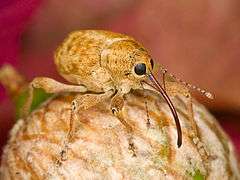Curculio occidentis
Curculio occidentis, the filbert weevil, is a species of weevil in the genus Curculio. They are considered a pest for many species of oak tree due to the damage they cause to acorns.[1][2]
| Filbert weevil | |
|---|---|
 | |
| A filbert weevil (Curculio occidentis) on an acorn cap | |
| Scientific classification | |
| Kingdom: | |
| Phylum: | |
| Class: | |
| Order: | |
| Family: | |
| Genus: | |
| Species: | C. occidentis |
| Binomial name | |
| Curculio occidentis | |
Distribution
Curculio occidentis is native to the western side of North America. Its range includes British Columbia in Canada, California, Arizona, New Mexico and Utah in the United States, and Mexico.[3]
Ecology
The female Curculio occidentis lays small batches of typically two to four eggs in a developing acorn. The resulting larvae feed on the kernel and when fully developed, tunnel out of the nut, fall to the ground and dig themselves a small chamber. They may wait one or two years before pupating.[4]
Together with larva of the filbertworm moth (Cydia latiferreana), the filbert weevil feeds on the acorns of several species of oak tree. In British Columbia, up to 66% of acorns from garry oak (Quercus garryana) were infected with these larvae. These acorns are still able to germinate, but the germination rate is lower than for uninfected nuts.[2]
References
- Filbert Pests in Live Oaks, University of California.
- Waller, Jennifer (2010). "The Effects of the Filbert Weevil (Curculio occidentis) and the Filbertworm (Cydia latiferreana) on Garry Oak (Quercus garryana) Acorn Germination on Vancouver Island". viuspace.viu.ca. Vancouver Island University. doi:10.25316/IR-A7. Retrieved 2016-01-08.
- David Hagstrum (2009). Stored-Product Insect Resource. Elsevier. p. 68. ISBN 978-0-12-810456-9.
- Cranshaw, Whitney (2015). Garden Insects of North America: The Ultimate Guide to Backyard Bugs. Princeton University Press. p. 282. ISBN 978-1-4008-6678-6.
External links
- bugguide.net
- Curculio occidentis in the CalPhotos Photo Database, University of California, Berkeley
- discoverlife.org
- wiki.pestinfo.org
- sbnature.org